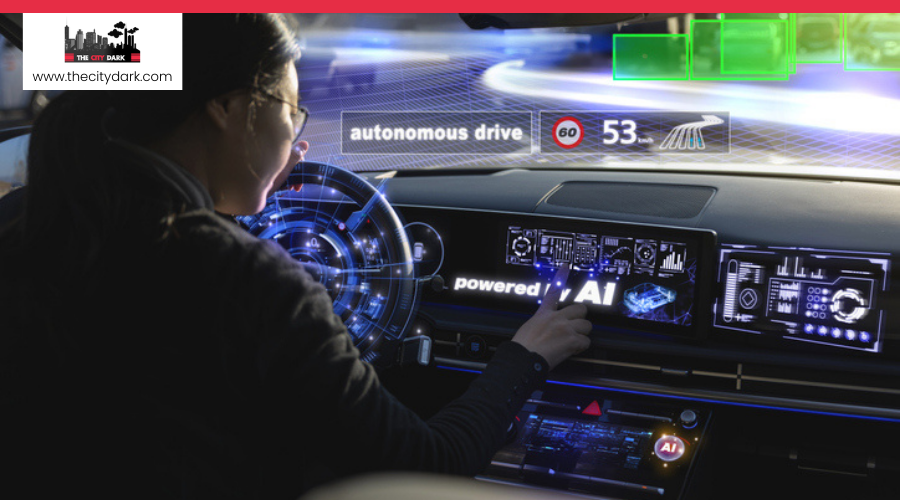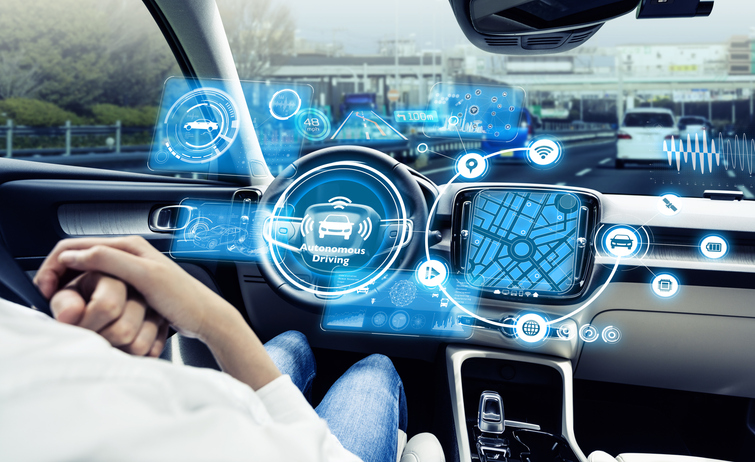Night vision in cars uses infrared to see hazards that your headlights miss, making night driving safer. It spots heat, showing hidden things like animals or people, and warns of danger. This technology not only makes dark roads brighter but also works with emergency braking to stop accidents. Features like adaptive lighting change to keep everyone safe, cutting down on glare. As it improves, it uses AI to predict dangers faster and more accurately. Think of driving confidently, knowing that hidden hazards are lit up before they’re in your way. Stay tuned to see how these advancements continue to enhance your safety.
Key Takeaways
- Night vision technology spots heat, making people and obstacles clear in the dark.
- It works with smart lights to cut glare and help see better, without dazzling other drivers.
- Smart AI spots dangers fast, giving quick, clear warnings to help drivers react sooner.
- It also helps self-driving cars see better at night, making travel safer.
- Drivers get fast updates on dangers ahead, helping them stay alert and react quickly in low light.
Understanding Night Vision
To grasp night vision in cars, know it uses infrared to see heat, helping see in dark or bad weather. This technology is key for safety, letting drivers spot people, animals, and obstacles hidden in darkness or fog.
Picture driving on a dark road. Suddenly, a person appears. Night vision helps you see them sooner. It does more than just show the road; it lets you understand dangers around you. With alerts for things like people in the road, it gives you extra time to react, making driving at night safer.
Night vision uses infrared to change how you see the road when it’s hard to see, improving safety in cars.
Infrared Headlights Explained
In the world of driving safety, infrared headlights use thermal imaging to light the way. This technology helps you avoid surprises from hidden hazards in the dark or bad weather. Unlike normal headlights, infrared ones let you see much further. They don’t just light up the road; they reveal a new night vision.
These headlights detect heat and show it on a dashboard screen. You can see people, animals, or obstacles long before they come into regular light. It’s as if you have a superpower that pierces through night, fog, or rain, boosting safety for you and others on the road.
Infrared headlights also work with pedestrian detection and emergency braking systems. This combination improves how quickly you notice dangers and react, helping to stop accidents before they start. With their advanced detection, infrared headlights play a crucial role in making roads safer. They’re not just for seeing in the dark; they’re about anticipating and avoiding risks, keeping everyone safer.
Active Systems Advancements
Building on the foundation of infrared headlights, advancements in active systems are pushing automotive safety further. You’re now entering a future where night vision is key to road safety. Active automotive night vision systems use infrared light to help you see in low visibility. These systems are not just better; they change how you see the road at night.
Active systems, offering higher resolution and better performance in warm conditions, outdo their passive counterparts. They come in two types: gated and non-gated, each aiming to improve your visibility. Near Infrared (NIR) cameras penetrate fog or rain, giving you clearer views. Far Infrared alerts you to obstacles ahead, enhancing safety.
Brands like Mercedes-Benz, Audi, and BMW lead in adding these advanced systems. Imagine a system that sees in the dark and warns you of pedestrians and animals ahead. This is not just about night driving; it’s about revolutionizing safety with every mile.
Passive Systems Evolution
Exploring the growth of passive night vision in cars reveals significant advancements in night safety. These systems now excel in identifying pedestrians and animals, helping drivers spot dangers ahead. They also adapt better to different weather, providing clear images in any temperature.
Enhanced Pedestrian Detection
The progress in passive night vision for spotting people walking at night is a big step for driver safety. These systems use heat cameras to see pedestrians, helping a lot when it’s dark.
Here’s how they’re changing the game for keeping drivers and pedestrians safe:
- Heat Cameras: They use infrared to find heat, so people can be seen even in the dark.
- Seeing Better: They let drivers see farther and more clearly, making it easier to notice people walking at night.
- Working with Other Safety Tech: These night vision systems are part of a bigger set of tools designed to stop crashes with pedestrians.
Even though there are issues like blurry images and not working as well when it’s hot, the advancements in night vision for cars are all about keeping roads safe for everyone.
Improved Animal Recognition
Advanced night vision now better spots road animals, enhancing night drive safety. Heat from animals makes them visible in darkness, increasing driver awareness. This prevents wildlife collisions, common at night. Improved animal recognition boosts automotive safety for night driving.
Enhanced night vision actively spots road animals, ensuring safer night drives. These systems make animals visible in darkness, heightening driver awareness. By better recognizing animals, technology reduces wildlife collisions. Improved recognition is a key step in bolstering automotive safety for night driving.
Advanced Weather Adaptability
Building on better animal spotting, night vision now tackles bad weather, making driving safer. Here’s the upgrade:
- Thermographic Cameras: These cameras boost sight range and clarity, crucial in rain, fog, and snow, by spotting living things better, they sharpen driver awareness.
- Warm Weather Hurdles: Great in the cold and damp, these systems falter in heat, underscoring the need for further improvement.
- Weather Focus: The main aim has been better sight in tough weather, enhancing safety by making sure drivers spot pedestrians and animals from afar clearer.
Thermal Imaging Benefits
By detecting heat from living things, thermal imaging makes driving at night much safer. This key technology in car night vision systems lets you see people and animals hidden in the dark. It’s about seeing more clearly, not just farther. Thermal imaging cuts through dim light and bad weather, putting heat differences right on your screen. This greatly improves what you can see, making sure sudden dangers don’t surprise you.
Thermal imaging also sees beyond normal headlights, giving you a better view of the road. This clearer vision is vital for safe night driving, a time when accidents are more likely. Cars with thermal imaging don’t just make it easier to see—they warn you of dangers, like a deer on the road or someone crossing in a poorly lit area.
This big jump in how aware drivers are is not just impressive; it changes driving at night. By making it much safer and clearer, thermal imaging in night vision systems is changing night travel for the better, keeping everyone safer.
Augmented Reality Displays
Augmented Reality (AR) displays transform your drive, laying out crucial data right on your windshield, distraction-free. Picture a drive in the night; darkness swallows everything, making it hard to see. AR steps in here, merging smoothly with Night Vision to light up the path ahead.
Instead of missing what’s hidden in darkness, AR and night vision reveal everything in your path. These rules applied make the explanation of AR’s role in enhancing driving safety more direct, engaging, and understandable.
Autonomous Emergency Braking
Autonomous Emergency Braking (AEB) systems spot danger ahead and brake instantly, cutting down collision risks. This tech shines at night. With sensors outperforming human sight in dim conditions, AEB acts as an ever-alert extra pair of eyes.
Here’s how AEB elevates nighttime driving safety:
| Feature | Explanation | Advantage |
|---|---|---|
| Sensors | Catch potential crash scenarios | Lessens accidents |
| Pedestrian & Cyclist Detection | Sees beyond vehicles | Lowers pedestrian and cyclist mishaps |
| Forward Collision Warning | Signals upcoming hazards | Readies brakes for swift action |
| Low Visibility Performance | Operates in weak lighting | Boosts night driving safety |
| Accident Statistics | Shown to cut down on rear-end smashes | Protects lives and diminishes harm |
AEB, with forward collision warning systems, signals dangers and gears your vehicle for a quicker stop than you might manage. It’s key for night safety, where dim visibility ups accident chances. By trimming rear-end smashes, AEB doesn’t just guard you; it marks a significant move towards safer roads for all.
AI Integration in Night Vision
Integrating AI into night vision significantly enhances its detection capabilities, ensuring clarity and precision in identifying potential hazards. This technology not only detects but also improves real-time responses, making decisions swiftly that can be crucial for safety. Moreover, with adaptive learning, your car learns from each drive, continuously refining its performance to adapt to your unique driving patterns and the changing environment.
Enhancing Detection Capabilities
Incorporating AI into night vision for cars sharpens their hazard-spotting skills, reshaping road safety. Here’s the transformation in simple terms:
- Immediate recognition with AI means quick spotting of danger, making driving safer.
- Learning over time, these systems not just see but understand surroundings, foreseeing risks before they happen.
- Clearer warnings now tell apart people, animals, and things, enhancing driver alertness and avoiding mishaps.
Real-Time Response Improvement
After exploring how AI sharpens hazard-spotting skills in night vision for cars, now we turn to its role in boosting real-time response. This makes driving safer and more efficient. AI in night vision systems analyzes data on-the-fly, improving response times significantly. It uses machine learning to predict what drivers might do next. This leads to safety measures that stop dangers before they happen.
Such foresight is key in choosing the best driving routes, adapting to traffic as it changes. Also, drivers can control features without their hands, thanks to voice recognition. This reduces distractions. The support AI provides not only improves the driving experience but also enhances safety on the road. With AI, you’re always one step ahead.
Adaptive Learning Features
Adaptive learning features in night vision systems transform night driving. They use AI to make seeing the road and spotting hazards fit how you drive. This blend of AI and smart predictions makes driving at night much safer. Here’s the simple breakdown:
- AI studies how you drive, then tweaks the night vision to help you see better and spot dangers sooner.
- AI helps find the best way to drive, avoiding traffic and dangers, making sure your path is both safe and quick.
- AI sends you alerts and tips tailored to you, helping avoid accidents and making driving at night better.
- These smart features ensure night driving is not just safer, but also more enjoyable.
Real-Time Data and Warnings
Using sharp, real-time data and warnings, night vision technology significantly boosts driver safety. It does so by making potential hazards in poor visibility conditions clear. The technology employs infrared cameras to spot the heat signatures of pedestrians, animals, and other obstacles, providing advanced alerts that could save lives. By illuminating dangers far beyond what traditional headlights can reveal, it ensures you’re always prepared.
The addition of features like pedestrian detection and emergency braking sharpens driver awareness, leading to faster reactions. This immediate insight is crucial, particularly when navigating through darkness or challenging weather, where visibility plummets.
To present this information in a straightforward way, let’s examine how these components work in unison to heighten safety:
- Infrared Cameras cut through the dark, spotting heat signals.
- Advanced Warning Systems signal upcoming hazards, cutting down accident risks.
- Pedestrian Detection zeroes in on people in the path, steering clear of collisions.
Future of Nighttime Automotive Safety
Looking forward, nighttime driving safety will change profoundly. New detection technologies, self-driving features, and smart lighting will make driving at night safer and more natural. Cars will soon have systems that see better in the dark and interact smoothly with everything around them to avoid accidents.
Enhanced Detection Technologies
Utilizing advanced detection technologies, today’s car night vision aids significantly bolster your safety by identifying pedestrians, animals, and hurdles in dim settings. These systems deploy both active and passive infrared sensors to heighten visibility during nocturnal drives. Here’s their impact on automotive safety, distilled through Hemingway’s four rules for writing well:
- Active night vision shines infrared light ahead, simplifying and enhancing pedestrian spotting.
- Passive night vision captures the warmth of living beings and objects, offering vivid scenes under any sky, without casting any light.
- By merging pedestrian detection with immediate braking, these systems sharply cut down accident risks.
- Night vision in cars, with these upgrades, is on its way to becoming a fundamental safety feature, promising you safer night-time journeys.
Autonomous Driving Integration
Integrating night vision with autonomous driving technology is a key step toward safer night travel. This combination allows cars to see pedestrians, animals, and obstacles even in dim light. Now, driving at night becomes less daunting, with enhanced safety.
Cars equipped with both night vision and autonomous capabilities navigate the dark more securely, reducing accident risks. This collaboration boosts road safety, enabling cars to handle poor lighting conditions effectively. Integrating night vision into autonomous driving systems is a major safety breakthrough, ensuring darkness no longer jeopardizes night travel safety.
Adaptive Lighting Systems
Adaptive lighting systems are a game-changer for driving at night, making it safer and more comfortable. They work by automatically adjusting the brightness and direction of headlights to ensure the best possible visibility. Here’s how these systems are making a difference, presented in the style of Hemingway’s four rules for writing well:
- Matrix headlights dim LEDs. They stop glare for others. Fewer accidents happen.
- Laser headlights shine far. They help drivers see early. Reaction times improve.
- e the dark. They find hidden objects. Drivers get early warnings.
- Instead of blinding, matrix headlights adjust. Instead of limiting view, laser headlights extend it. Instead of missing, infrared headlights detect.
Frequently Asked Questions
What Are the Benefits of Night Vision?
Night vision improves driving at night. It makes animals and people easier to see, helping avoid crashes. This makes night driving safer.
How Does a Night Vision System Help the Driver See?
Night vision uses infrared to make contrast better, helping you see in bad weather. It detects people and animals, making you aware of dangers on the road.
What Technology Is Used for Night Driving?
For night driving, use technology such as infrared headlights, thermal imaging, and light amplification. Cameras and adaptive lighting improve visibility, making it easier to drive in the dark.
What Helps With Night Time Driving?
For driving at night, use reflective signs, adjust headlights right, and add anti-glare. Be alert for tiredness. Add side lights for better seeing.
Conclusion
To conclude, night vision technology is transforming night-time road safety. Advances in infrared headlights, both active and passive systems, and thermal imaging make spotting hazards easier. The addition of AI and autonomous emergency braking enhances your confidence when driving at night. As data and warnings improve, the future of night-time driving safety is promising, making every journey safer.





